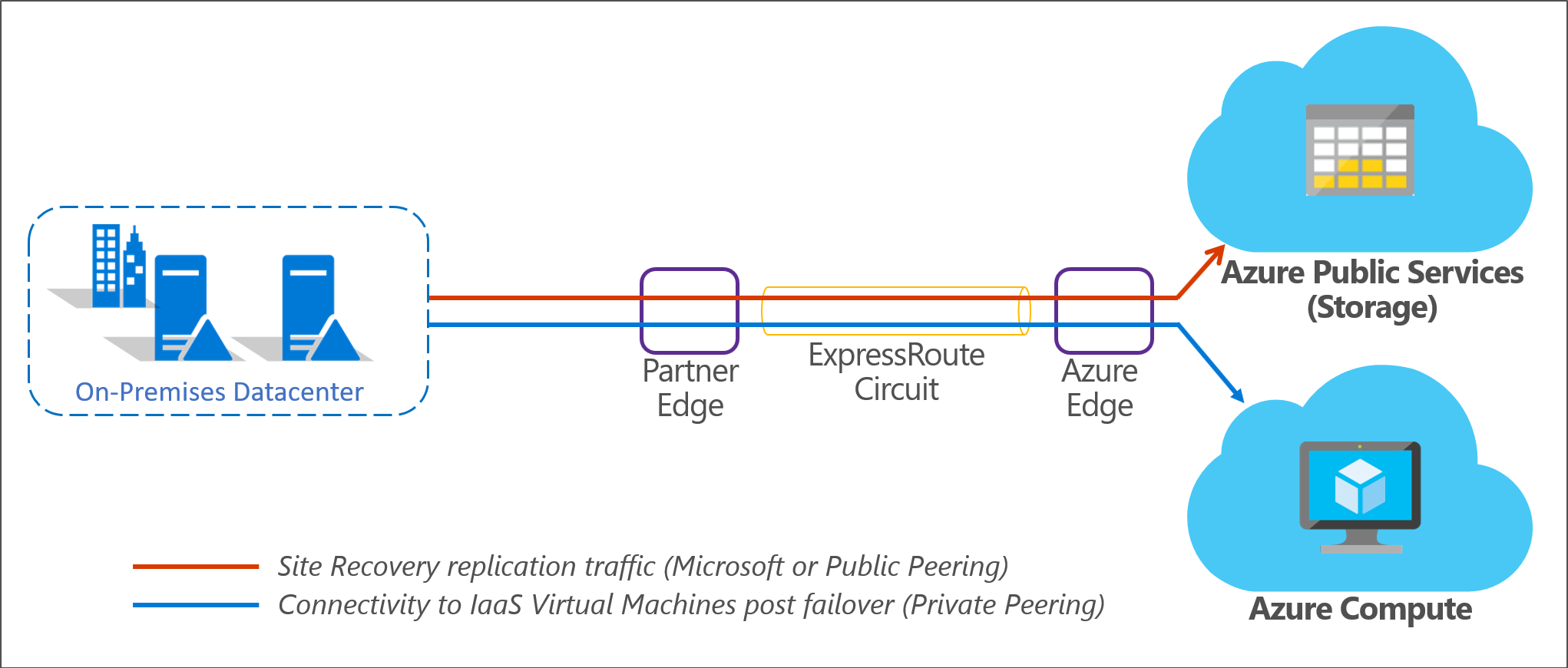Azure ExpressRoute with Azure Site Recovery
Microsoft Azure ExpressRoute lets you extend your on-premises networks into the Microsoft cloud over a private connection facilitated by a connectivity provider. With ExpressRoute, you can establish connections to Microsoft cloud services, such as Microsoft Azure, Microsoft 365, and Dynamics 365.
This article describes how you can use Azure ExpressRoute with Azure Site Recovery for disaster recovery and migration.
ExpressRoute circuits
An ExpressRoute circuit represents a logical connection between your on-premises infrastructure and Microsoft cloud services through a connectivity provider. You can order multiple ExpressRoute circuits. Each circuit can be in the same or different regions, and can be connected to your premises through different connectivity providers. Learn more about ExpressRoute circuits here.
An ExpressRoute circuit has multiple routing domains associated with it. Learn more about and compare ExpressRoute routing domains here.
On-premises to Azure replication with ExpressRoute
Azure Site Recovery enables disaster recovery and migration to Azure for on-premises Hyper-V virtual machines, VMware virtual machines, and physical servers. For all on-premises to Azure scenarios, replication data is sent to and stored in an Azure Storage account. During replication, you don't pay any virtual machine charges. When you run a failover to Azure, Site Recovery automatically creates Azure IaaS virtual machines.
Site Recovery replicates data to an Azure Storage account or replica Managed Disk on the target Azure region over a public endpoint. To use ExpressRoute for Site Recovery replication traffic, you can utilize Microsoft peering. Note that replication is supported over private peering only when private ends points are enabled for the vault.
Ensure that the Networking Requirements for Configuration Server are also met. Connectivity to specific URLs is required by Configuration Server for orchestration of Site Recovery replication. ExpressRoute cannot be used for this connectivity.
In case you use proxy at on-premises and wish to use ExpressRoute for replication traffic, you need to configure the Proxy bypass list on the Configuration Server and Process Servers. Follow the steps below:
- Download PsExec tool from here to access System user context.
- Open Internet Explorer in system user context by running the following command line psexec -s -i "%programfiles%\Internet Explorer\iexplore.exe"
- Add proxy settings in Internet Explorer
- In the bypass list, add the Azure storage URL
*.blob.core.windows.net
This will ensure that only replication traffic flows through ExpressRoute while the communication can go through proxy.
After virtual machines or servers fail over to an Azure virtual network, you can access them using private peering.
The combined scenario is represented in the following diagram:

Azure to Azure replication with ExpressRoute
Azure Site Recovery enables disaster recovery of Azure virtual machines. Depending on whether your Azure virtual machines use Azure Managed Disks, replication data is sent to an Azure Storage account or replica Managed Disk on the target Azure region. Although the replication endpoints are public, replication traffic for Azure VM replication, by default, does not traverse the Internet, regardless of which Azure region the source virtual network exists in. You can override Azure's default system route for the 0.0.0.0/0 address prefix with a custom route and divert VM traffic to an on-premises network virtual appliance (NVA), but this configuration is not recommended for Site Recovery replication. If you're using custom routes, you should create a virtual network service endpoint in your virtual network for "Storage" so that the replication traffic does not leave the Azure boundary.
For Azure VM disaster recovery, by default, ExpressRoute is not required for replication. After virtual machines fail over to the target Azure region, you can access them using private peering. Note that data transfer prices apply irrespective of the mode of data replication across Azure regions.
If you are already using ExpressRoute to connect from your on-premises datacenter to the Azure VMs on the source region, you can plan for re-establishing ExpressRoute connectivity at the failover target region. You can use the same ExpressRoute circuit to connect to the target region through a new virtual network connection or utilize a separate ExpressRoute circuit and connection for disaster recovery. The different possible scenarios are described here.
You can replicate Azure virtual machines to any Azure region within the same geographic cluster as detailed here. If the chosen target Azure region is not within the same geopolitical region as the source, you might need to enable ExpressRoute Premium. For more details, check ExpressRoute locations and ExpressRoute pricing.
Next steps
- Learn more about ExpressRoute circuits.
- Learn more about ExpressRoute routing domains.
- Learn more about ExpressRoute locations.
- Learn more about disaster recovery of Azure virtual machines with ExpressRoute.